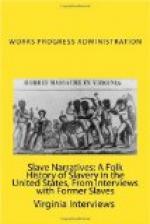“There was a big oak tree in front. The boys played on one side, the girls on the other. Cake and pie was a fortune then. If the children had any they would give me part of it. Times was so hard then people had plain victuals every day at school.
“The children tried to learn me at recess under the tree. They used McGuffey’s and Blue Back books. One day I said out loud, ’I want to go home.’ The children all laughed. One day I went to sleep and the teacher sent me out doors to play. Mrs. McCallis said, ’Bunny, you mus’n’t talk out loud in school.’ I was nodding one day. The teacher woke me up. She wrapped her long switch across the table. She sent me to play. The house set up on high blocks. I got under it and found some doodle holes. Mrs. McCallis come to the door and said, ’Bunny, don’t call so loud. You must keep quiet.’ I would say: ’Doodle, doodle, your house on fire. Come get some bread and butter.’ They would come up.
“After the War I had a white lady teacher from the North. I went a little bit to colored school but I didn’t care about books. I learned to sew for my dolls. The children would give me a doll all along.
“The happiest year of my whole life was the first year of my married life. I hardly had a change of clothes. I had lots of friends. I went to the field with Scott. I pressed cotton with two horses, one going around and the other coming. Scott could go upstairs in the gin and look over at us. We had two young cows. They had to be three years old then before they were any service. I fed hogs. I couldn’t cook but I learned. I had been a house girl and nurse.
“I was nursing for Mrs. Pierce at Goodwin. I wanted to go home. She didn’t want me to leave. I wouldn’t tell her why. She said, ’I speck you going to get married.’ She gave me a nice white silk dress. Mrs. Drennand made it. My owner, Miss Leila Nash, lend me one of her chemisette, a corset cover, and a dress had ruffles around the bottom. It was wide. She never married. I borrowed my veil from a colored woman that had used it. Mr. Rollwage (dead now but was a lawyer at Forrest City) gave Scott a tie and white vest and lend him his watch and chain to be married in. They was friends. Miss Leila made my cake. She wanted my gold band ring to go in it. I wouldn’t let her have it for that. Not my ring! She put a dime in it. Miss Maggie Barrow and Mrs. Maggie Hatcher made two baskets full of maple biscuits for my wedding. They was the best cake. Made in big layers and cut and iced. Two laundry baskets full to the brim.”
She showed us a white cedar three-gallon churn, brass hoops hold the staves in place, fifty-seven years old and a castor with seven cruits patented December 27, 1859. It was a silver castor and was fixed to ring for the meal.
She showed us the place under a cedar tree where there are four unmarked graves—Mr. and Mrs. McMurray and their son and daughter and one niece. The graves are being ploughed over now.




